- Manuals
- Brands
- KTM Manuals
- Motorcycle
- 990 SMT
Manuals and User Guides for KTM 990 SMT. We have 1 KTM 990 SMT manual available for free PDF download: Owner’s Manual
- Manuals
- Brands
- KTM Manuals
- Motorcycle
- 990 SupermotoR
Manuals and User Guides for KTM 990 SupermotoR. We have 3 KTM 990 SupermotoR manuals available for free PDF download: Repair Manual, Owner’s Manual
KTM 990 SupermotoR Repair Manual (448 pages)
Brand: KTM
|
Category: Motorcycle
|
Size: 30.17 MB
Table of Contents
-
Important Information/Updating Instructions
7
-
Storing the Repair Manual in the Binder
7
-
General Information
15
-
Oil System
17
-
Intake System
18
-
Secondary Air System
19
-
Cooling System
20
-
Closed Thermostat
20
-
Open Thermostat
20
-
ABS (Antilock Brake System)
21
-
ABS Warning Lamp
21
-
ABS Button
21
-
Special Tools – Engine
22
-
Special Tools – Chassis
24
-
Checking the Oil Level of the Hydraulic Clutch
25
-
Bleeding of the Hydraulic Clutch
25
-
Resetting the Control Unit after Replacing/Repairing the Engine
26
-
Adjusting the Throttle Cable for Models with Fuel Injection
27
-
ECU Software Update/Mapping
28
-
Starting the DMT (Data Maintenance Tool)
29
-
Starting the FAN (Flash Download System)
29
-
Checking the Oil Pressure
30
-
Table of Contents
31
-
Removing and Refitting Engine
31
-
Removing the Engine — 950 Adventure
33
-
Refitting the Engine — 950 Adventure
38
-
Removing the Engine — 990 Adventure
43
-
Refitting the Engine
49
-
Dismounting the Engine — 990 Super Duke
55
-
Mounting the Engine — 990 Super Duke
56
-
Dismounting the Engine — 990 Super Duke R
63
-
Removing the Engine — 990 Supermoto
66
-
Refitting the Engine — 990 Supermoto
71
-
Disassembling the Engine
77
-
Valve Covers
79
-
Spark Plug Shaft Inserts
79
-
Starter Motor
79
-
Setting Cylinder Rear to TDC
80
-
Camshafts Cylinder Rear
80
-
Chain Tensioner Cylinder Rear
81
-
Timing Chain Cylinder Rear
81
-
Setting Cylinder Front to TDC
82
-
Double Timing Gear
82
-
Cylinder Head Rear with Cylinder
82
-
Camshafts Cylinder Front
83
-
Oil Pressure Switch
83
-
Chain Tensioner Cylinder Front
83
-
Timing Chain Cylinder Front
84
-
Cylinder Head Front with Cylinder
84
-
Water Pump
85
-
Oil Screen
85
-
Clutch Cover
85
-
Clutch
86
-
Primary Pinion and Clutch
87
-
Rotor
88
-
Freewheel
89
-
Balancer Shaft
89
-
Shift Mechanism
89
-
Engine Case Half
90
-
Transmission
91
-
Oil Pumps
92
-
Servicing Individual Components
93
-
Replacing the Roller Bearing
95
-
Replacing the Main Bearings-General Information
96
-
Replacing Bearing Shells, Output End
97
-
Replacing Bearing Shells, Generator End
97
-
Replacing the Conrod Bearings
98
-
Selecting the Bearing Shells
98
-
Replacing the Supporting Bearings in the Clutch Cover
99
-
Overhauling the Water Pump
100
-
Checking the Pressure Pump for Wear
101
-
Checking the Suction Pump for Wear
101
-
Disassembling the Cylinder Head and Checking Parts for Wear
102
-
Sealing Area
102
-
Valve Seats
102
-
Valve Guides
102
-
Checking the Pistons
103
-
Checking the Piston Ring End Gap
103
-
Assembly Instructions for Piston Rings
103
-
Measuring Pistons and Cylinders, Establishing the Piston Mounting Clearance
103
-
Assembling the Cylinder Head
104
-
Piston and Cylinder Identification
104
-
Generator Cover
106
-
Torque Limiter
106
-
Valve Gear – Checking Parts for Wear
106
-
Preassembling the Spreader Drive
107
-
Clutch – Checking Parts for Wear
108
-
Shift Mechanism – Checking Parts for Wear
109
-
Preassembling the Shift Shaft
109
-
Assembling the Main Shaft
110
-
General Information on Servicing the Transmission
110
-
Assembling the Countershaft
111
-
Checking the Freewheel
112
-
Replacing the Freewheel Hub
112
-
Starter
112
-
Assembling the Engine
113
-
Axial Clearance of the Main Shaft
116
-
Case Half
118
-
Aligning the Return Spring
119
-
Timing Chain and Balancing Weight
121
-
Outer Clutch Hub
122
-
Primary Pinion
122
-
Clutch Disks
123
-
Water Pump
125
-
Cylinder Head Rear with Timing Chain
126
-
Electrical
137
-
Abs-System
139
-
Checking for Loss of Current
141
-
Checking the Charging Voltage / Rectifier Regulator
141
-
Checking the Generator Coils
141
-
Electric Starter System 950 Adventure
142
-
Electric Starter System 990 Super Duke/R
143
-
Electric Starter System 950 Supermoto/R, 950 Super Enduro
144
-
Electric Starter System 990 Adventure -2007
145
-
Starting System 990 Adventure 2007-
146
-
Starting System 990 Supermoto
147
-
Checking the Auxiliary Starter Relay
148
-
Functional Check of the Auxiliary Starter Relay (950 Adventure)
149
-
Functional Check of the Auxiliary Start Relay (990 Adventure/ 990 Super Duke/R)
149
-
Functional Check of the Auxiliary Start Relay (950 Supermoto/R, 990 Supermoto)
149
-
Checking the Diodes
150
-
Checking the Starter Relay
151
-
Checking the Starter Motor
151
-
Checking the Clutch Switch
152
-
Checking the Tip Switch and Emergency off Switch
153
-
Troubleshooting in the Starter System
153
-
Ignition System, ECU 950 Adventure
154
-
Ignition System, ECU 950 Supermoto
155
-
Ignition System, ECU 950 Super Enduro
156
-
Checking the Pulse Generator 950 Adventure/950 Supermoto
157
-
ECU 950 Adventure/Supermoto/Super Enduro
157
-
Checking the Fuel Pump Relay 950 Adventure/950 Supermoto
158
-
Checking the Ignition Coils 950 Adventure/Supermoto/Super Enduro
158
-
Troubleshooting in the Ignition System 950 Adventure/950 Supermoto
159
-
The EPC System 950 Adventure
160
-
The EPC System 950 Supermoto/R
161
-
EPC System 950 Super Enduro
162
-
Checking the Solenoid Valve for the EPC 950 Adventure, 950 Supermoto/R, 950 Super Enduro
163
-
Checking the Gear Sensor 950 Adventure, 950 Supermoto/R, 950 Super Enduro
163
-
Checking the Temperature Switch
164
-
Checking the Heating Elements
164
-
Adventure Carburetor Heater 950 Adventure, 950 Supermoto/R, 950 Super Enduro
164
-
Injection/Ignition System
165
-
Establishing the Injection Period (Injection Volume)
165
-
Correction Sensors and Inputs
165
-
System Diagram
166
-
Wiring Diagram 990 Super Duke
168
-
Schaltplan 990 Super Duke R
169
-
Wiring Diagram 990 Supermoto
170
-
Wiring Diagram 990 Adventure -2007
171
-
Wiring Diagram 990 Adventure 2007-
172
-
Block Diagram
173
-
Description of the Electric System
174
-
Fuel Pump Relay
174
-
Main Relay
174
-
Sensors
174
-
Description of the Components
175
-
Fuel Pump
175
-
Pressure Regulator
175
-
Injection Valves
175
-
Sensor for the 2Nd Throttle Valve
176
-
Manifold Air Pressure Sensor
176
-
Throttle Valve Sensor
176
-
Ambient Air Pressure Sensor
176
-
Pulse Generator (Crankshaft)
177
-
Lambda Probes
177
-
Catalytic Converter
178
-
Idle Speed Control Motor
178
-
Servomotor for the 2Nd Throttle Valve
178
-
Octane Selector Connections (990 Adventure Only)
179
-
Secondary Air Valve
179
-
Ignition Coils
179
-
Roll Angle Sensor
180
-
Diagnostics Connector
180
-
Side Stand Switch
180
-
Clutch Switch
180
-
Safety against Failure/Emergency Operation
181
-
Component Tests
182
-
Coolant Temperature Sensor
183
-
Air Temperature Sensor
183
-
Intake Pressure Sensors
184
-
Sensor for 2Nd Throttle Valve
185
-
Pulse Generator
186
-
Control Motor for the 2Nd Throttle Valve
187
-
Gear Sensor (Neutral, 2, 3)
191
-
Error Lamp
191
-
Speed Signal
192
-
Coolant Temperature Signal
192
-
Diagnostics Line
192
-
Abbreviations, Limit Values 990 Super Duke/R
194
-
Abbreviations, Limit Values 990 Adventure / 990 Supermoto
195
-
Alarm System for 990 Super Duke/R (Optional)
196
-
Order for Additional Hand-Held Transmitters
197
-
Adapting the Hand-Held Transmitter
197
-
Starting with the Emergency Code
198
-
ABS System 990 Adventure
199
-
Checking the Fuses
199
-
Checking the ABS Fault Memory Using the KTM Diagnostics Tool
199
-
Checking the ABS Sensor with the KTM Diagnostics Tool
199
-
Fuel System
200
-
Carburator — Keihin Cvrd 43
202
-
Description of the ACV (Air Cut Valve) System
203
-
Disassembling the Carburetor
204
-
Assembling the Carburetor
207
-
Adjusting the Float Level
210
-
Adjusting the Idle Mixture Control Screw
210
-
Checking the Throttle Sensor
211
-
Adjusting the Throttle Sensor
211
-
Adjusting the Choke Cable
211
-
Adjusting the Throttle Cable (Carburetor Models Only)
211
-
Carburetor Heater
212
-
Replacing the Fuel Filter
213
-
Dismounting/Mounting the Throttle Body
213
-
Dismounting/Mounting the Fuel Pump with Pressure Regulator
213
-
Checking the Fuel Pressure
214
-
Trouble Shooting
216
-
Chassis
220
-
Dismounting/Mounting the Front Wheel
222
-
Dismounting/Mounting the Rear Wheel
223
-
Replacing the Front Wheel Bearing
224
-
Replacing the Rear Wheel Bearing
225
-
Replacing the Front Brake Pads (950/990 Adventure)
226
-
Replacing the Rear Brake Pads (990 Super Duke/R)
227
-
Replacing the Fork Legs
228
-
Replacing the Shock Absorber (950/990 Adventure)
229
-
Replacing the Steering Head Bearing
231
-
Replacing the Swing Arm Bearing
232
-
Replacing the Chain, Pinion and Rear Sprocket
233
-
Opening the Chain with a Separating/Rivet Tool
234
-
Riveting the Chain
234
-
Replacing the Rear ABS Sensor
235
-
Replacing the Front ABS Sensor
235
-
Replacing the ABS Unit
235
-
Technical Specifications
236
-
Technical Specifications – Engine 950 Adventure
238
-
Basic Carburetor Setting
238
-
Technical Specifications – Chassis 950 Adventure/Adventure S
239
-
Technical Specifications – Engine 990 Super Duke / Super Duke R
241
-
Technical Specifications – Chassis 990 Duke / Super Duke R
242
-
Technical Specifications – Engine 950 Supermoto / Supermoto R
244
-
Technical Specifications – Chassis 950 Supermoto / Supermoto R
245
-
Technical Specifications – Engine 990 Adventure
247
-
Technical Specifications – Chassis 990 Adventure/Adventure S
248
-
Technical Specifications – Engine 990 Supermoto
250
-
Technical Specifications – Chassis 990 Supermoto
251
-
Technical Specifications – Engine 950 Super Enduro
253
-
Technical Specifications – Chassis 950 Super Enduro
254
-
Tolerances and Fitting Clearances
256
-
Tightening Torques – Engine
258
-
Tightening Torques – Chassis
259
-
Periodic Maintenance Schedule
260
-
Lubrication and Maintenance Work — Engine
273
-
Engine Oil
274
-
Checking the Engine Oil Level
275
-
Replacing the Spark Plugs
275
-
Checking and Adjusting the Valve Clearance
276
-
Number/Thickness of the Demounted Compensating Washer (Shim) in MM
277
-
Checking the Clutch Lining
279
-
Checking the Clutch Pressure Booster System
279
-
Cleaning the Oil Jet for the Clutch Lubrication
279
-
Checking the Idle Setting (950 Adventure)
280
-
Check the Carburetor Synchronization with an Vacuum Gauge and Adjust if Necessary
280
-
Lubrication and Maintenance Work – Carburetor
280
-
Lubricating the Cables
281
-
Checking the Idle Setting (950 Supermoto/Super Enduro)
281
-
Lubrication and Maintenance Work – Add-On Parts
281
-
Lubrication and Maintenance Work — Injection
281
-
Changing the Front Brake Fluid
282
-
Changing the Rear Brake Fluid
283
-
Lubrication and Maintenance Work — Chassis
284
-
Checking/Adjusting the Steering Head Bearing
284
-
Lubrication and Maintenance Work — Wheels
285
-
Checking the Spoke Tension and Rim Run-Out
285
-
Completely Servicing the Shock Absorber
286
-
Lubrication and Maintenance Work – Additional Work
286
-
Changing the Cooling Liquid
287
-
Wiring Diagrams
288
-
Multifunctional Digital Speedometer
315
-
Start/Stop/Light Switch
315
-
Front Light
315
-
Light/Turn Signal/Horn Switch
315
-
Left Front Turn Signal
316
-
Tachometer
316
-
Rear Brake Light Switch
316
-
Turn Signal Relay
316
-
Diode Neutral Switch
317
-
Diode Side Stand Switch
317
-
Rear Lighting
317
-
Right Front Turn Signal
317
-
Gear Sensor
318
-
Carburetor Potentiometer
318
-
Pick up
318
-
Tripmaster Switch
319
-
ECU (Control Unit)
319
-
Ignition Lock
319
-
Connector for Auxiliary Devices
319
-
Speed Sensor
320
-
Rear Ignition Coil
320
-
Fuel Sender
320
-
EPC Front Cylinder
321
-
Temperature Switch for the Radiator Fan
321
-
Regulator
321
-
Radiator Fan Motor
321
-
Temperature Sensor for the Multifunctional Digital Speedometer
322
-
Rear Turn Signal
322
-
Octane Selector
322
-
990 Super Duke 2005/06 Wiring Diagram
325
-
Battery Generator Starter Diagram
327
-
ECU Diagram
331
-
Turn Signal, Horn, Fan Diagram
335
-
Light-Brake System Diagram
337
-
Instruments-Tachometer Diagram
339
-
Ground Connection
343
-
Positive Connection
344
-
Controller Outlet
380
-
Temperature Switch
380
-
Front EPC
380
-
950 Super Enduro 2006/07 Diagram
420
-
950 Super Enduro 2007-2008 Wiring Diagram
422
-
990 Supermoto 2008 Diagram
445
-
Advertisement
KTM 990 SupermotoR Owner’s Manual (208 pages)
Brand: KTM
|
Category: Motorcycle
|
Size: 3.37 MB
Table of Contents
-
Table of Contents
5
-
Table of Contents
8
-
Means of Representation
9
-
Important Information
10
-
Overview of Labels
14
-
-
View of Vehicle
24
-
View of Vehicle, Front Left Side (Vehicle Differs Slightly from Photo)
24
-
View of Vehicle, Rear Right Side (Vehicle Differs Slightly from Photo)
26
-
-
Serial Numbers
28
-
Chassis Number/Type Label
28
-
Key Number
29
-
Engine Number
30
-
Fork Part Number
30
-
Shock Absorber Part Number
31
-
-
Controls
32
-
Clutch Lever
32
-
Hand Brake Lever
32
-
Throttle Grip
33
-
Light Switch
33
-
Headlight Flasher Switch
34
-
Turn Signal Switch
34
-
Horn Button
35
-
Ignition/Steering Lock
35
-
Immobilizer
36
-
Emergency off Switch
36
-
Electric Starter Button
37
-
Combination Instrument
37
-
Combination Instrument — Function Buttons
38
-
Combination Instrument — Tachometer
38
-
Combination Instrument — Indicator Lamps
39
-
Combination Instrument — Display
40
-
Combination Instrument — Speedometer
41
-
Setting Kilometers or Miles
41
-
Combination Instrument — Time
42
-
Setting the Clock
42
-
Combination Instrument — ODO Display
43
-
Combination Instrument — Setting/Resetting TRIP 1
43
-
Combination Instrument — Setting/Resetting TRIP 2
44
-
Combination Instrument — TRIP F Display
45
-
Combination Instrument — Ambient Temperature Display
45
-
Setting the Temperature Units
46
-
Combination Instrument — Warning of Slippery Roads
46
-
Combination Instrument — Coolant Temperature Indicator
47
-
Opening the Filler Cap
47
-
Closing the Filler Cap
48
-
Handrails
49
-
Seat Lock
49
-
Tool Set
50
-
Helmet Lock
50
-
Passenger Footrests
51
-
Shift Lever
51
-
Foot Brake Lever
52
-
Side Stand
53
-
-
Preparing for Use
54
-
Information on First Use
54
-
Running in the Engine
55
-
Loading the Vehicle
55
-
-
Riding Instructions
58
-
Checks and Maintenance Measures When Preparing for Use
58
-
Starting
59
-
Starting off
60
-
Shifting, Riding
61
-
Braking
64
-
Stopping, Parking
65
-
Refueling
67
-
-
Service Schedule
69
-
Tuning the Chassis
72
-
Fork/Shock Absorber
72
-
Adjusting the Compression Damping of the Fork
72
-
Adjusting the Rebound Damping of the Fork
73
-
Adjusting the Spring Preload of the Fork
74
-
Compression Damping of the Shock Absorber
76
-
Adjusting the Low-Speed Compression Damping of the Shock Absorber
76
-
Adjusting the High-Speed Compression Damping of the Shock Absorber
77
-
Adjusting the Rebound Damping of the Shock Absorber
78
-
Adjusting the Spring Preload of the Shock Absorber
79
-
Service Work on the Chassis
81
-
Raising the Motorcycle with the Front Wheel Stand
81
-
Taking the Motorcycle off of the Front Wheel Stand
81
-
Raising the Motorcycle with the Rear Wheel Stand
82
-
Taking the Motorcycle off of the Rear Wheel Stand
82
-
Bleeding the Fork Legs
83
-
Removing the Seat
83
-
Mounting the Seat
84
-
Mounting the Helmet Lock on the Vehicle
84
-
Reinstalling the Fuel Tank
85
-
Positioning the Fuel Tank
86
-
Checking the Chain for Dirt
88
-
Cleaning the Chain
88
-
Checking the Chain Tension
89
-
Adjusting the Chain Tension
90
-
Checking the Chain, Rear Sprocket and Engine Sprocket
92
-
Adjusting the Basic Position of the Clutch Lever
94
-
Checking/Rectifying the Fluid Level of the Hydraulic Clutch
95
-
-
Brakes
96
-
Adjusting the Basic Position of the Hand Brake Lever
96
-
Checking the Front Brake Discs
96
-
Checking the Front Brake Fluid Level
97
-
Adding Front Brake Fluid
98
-
Brake Linings
99
-
Checking the Front Brake Linings
99
-
Checking the Free Travel of the Foot Brake Lever
100
-
Checking the Rear Brake Disc
101
-
Checking the Rear Brake Fluid Level
102
-
Adding Rear Brake Fluid
103
-
Checking the Rear Brake Linings
104
-
-
Wheels, Tires
106
-
Removing the Front Wheel
106
-
Installing the Front Wheel
107
-
Removing the Rear Wheel
109
-
Installing the Rear Wheel
110
-
Checking Rear Hub Shock Absorbers
111
-
Checking the Tire Condition
112
-
Checking the Tire Air Pressure
114
-
-
Electrical System
116
-
Removing the Battery
116
-
Installing the Battery
117
-
Recharging the Battery
118
-
Changing the Main Fuse
120
-
Changing the Fuses of Individual Power Consumers
122
-
Changing the Headlight Bulb
124
-
Changing the Parking Light Bulb
126
-
Changing the Turn Signal Bulb
129
-
Changing the Brake Light Bulb
130
-
Changing the Tail Light Bulbs
134
-
Changing the License Plate Lamp
138
-
Checking the Headlight Setting
139
-
Adjusting Headlight Range
140
-
Activating/Deactivating the Ignition Key
140
-
-
Cooling System
145
-
Checking the Antifreeze and Coolant Level
145
-
Checking the Coolant Level in the Compensating Tank
147
-
Draining the Coolant
149
-
Filling/Bleeding the Cooling System
150
-
-
Checking the Play in the Throttle Cable
153
-
Tuning the Engine
153
-
Adjusting the Play in the Throttle Cable
154
-
Ignition Curve Plug-In Connector
154
-
Adjusting the Ignition Curve to the Fuel Quality
155
-
Checking the Basic Position of the Shift Lever
155
-
Adjusting the Basic Position of the Shift Lever
156
-
-
Service Work on the Engine
157
-
Checking the Engine Oil Level
157
-
Changing the Engine Oil and Filter, Cleaning the Oil Screens X
158
-
Draining the Engine Oil and Filter, Cleaning the Oil Screens X
158
-
Filling up with Engine Oil
163
-
Adding Engine Oil
164
-
-
Cleaning, Care
165
-
Cleaning Motorcycle
165
-
Protective Treatment for Winter Operation
167
-
-
Storage
168
-
Preparing for Use after Storage
169
-
-
Troubleshooting
170
-
Immobilizer Blink Code
173
-
Engine Control Blink Code
175
-
Technical Data — Engine
181
-
Capacity- Engine Oil
182
-
Capacity — Coolant
182
-
-
Technical Data — Engine Tightening Torques
183
-
Technical Data — Chassis
187
-
Lighting Equipment
188
-
Tires
189
-
Capacity — Fuel
189
-
-
Technical Data — Fork
190
-
Technical Data — Shock Absorber
191
-
Technical Data — Chassis Tightening Torques
193
-
Substances
196
-
Auxiliary Substances
200
-
Standards
202
-
Index
203
KTM 990 SupermotoR Owner’s Manual (205 pages)
Brand: KTM
|
Category: Motorcycle
|
Size: 3.18 MB
Table of Contents
-
Table of Contents
5
-
Means of Representation
9
-
Important Information
10
-
View of Vehicle
14
-
View of Vehicle, Front Left Side (Vehicle Differs Slightly from Photo)
14
-
View of Vehicle, Rear Right Side (Vehicle Differs Slightly from Photo)
16
-
-
Serial Numbers
18
-
Chassis Number/Type Label
18
-
Engine Number
19
-
Key Number
19
-
Fork Part Number
20
-
Shock Absorber Part Number
20
-
-
Controls
21
-
Clutch Lever
21
-
Hand Brake Lever
21
-
Throttle Grip
22
-
Light Switch
22
-
Headlight Flasher Switch
23
-
Turn Signal Switch
23
-
Horn Button
24
-
Emergency off Switch
24
-
Electric Starter Button
25
-
Ignition/Steering Lock
25
-
Immobilizer
26
-
Combination Instrument
26
-
Combination Instrument — Function Buttons
27
-
Combination Instrument — Tachometer
27
-
Combination Instrument — Indicator Lamps
28
-
Combination Instrument — Display
29
-
Combination Instrument — Speedometer
30
-
Setting Kilometers or Miles
30
-
Combination Instrument — Time
31
-
Setting the Clock
31
-
Combination Instrument — ODO Display
32
-
Combination Instrument — Setting/Resetting TRIP 1
32
-
Combination Instrument — Setting/Resetting TRIP 2
33
-
Combination Instrument — TRIP F Display
34
-
Combination Instrument — Ambient Temperature Display
34
-
Setting the Temperature Units
35
-
Combination Instrument — Warning of Slippery Roads
35
-
Combination Instrument — Coolant Temperature Indicator
36
-
Opening the Filler Cap
36
-
Closing the Filler Cap
37
-
Seat Lock
38
-
Tool Set
38
-
Handrails
39
-
Helmet Lock
39
-
Passenger Footrests
40
-
Shift Lever
40
-
Foot Brake Lever
41
-
Side Stand
42
-
-
Preparing for Use
43
-
Information on First Use
43
-
Running in the Engine
44
-
Loading the Vehicle
44
-
-
Riding Instructions
47
-
Checks and Maintenance Measures When Preparing for Use
47
-
Starting
48
-
Starting off
50
-
Shifting, Riding
50
-
Braking
53
-
Stopping, Parking
55
-
Refueling
56
-
-
Service Schedule
58
-
Tuning the Chassis
61
-
Fork/Shock Absorber
61
-
Adjusting the Compression Damping of the Fork
61
-
Adjusting the Rebound Damping of the Fork
62
-
Adjusting the Spring Preload of the Fork
63
-
Compression Damping of the Shock Absorber
65
-
Adjusting the Low-Speed Compression Damping of the Shock Absorber
65
-
Adjusting the High-Speed Compression Damping of the Shock Absorber
66
-
Adjusting the Rebound Damping of the Shock Absorber
67
-
Adjusting the Spring Preload of the Shock Absorber
68
-
Service Work on the Chassis
70
-
Raising the Motorcycle with the Front Wheel Stand
70
-
Taking the Motorcycle off of the Front Wheel Stand
70
-
Raising the Motorcycle with the Rear Wheel Stand
71
-
Taking the Motorcycle off of the Rear Wheel Stand
71
-
Bleeding the Fork Legs
72
-
Removing the Seat
72
-
Mounting the Seat
73
-
Mounting the Helmet Lock on the Vehicle
73
-
Reinstalling the Fuel Tank
74
-
Positioning the Fuel Tank
75
-
Checking the Chain for Dirt
77
-
Cleaning the Chain
77
-
Checking the Chain Tension
78
-
Adjusting the Chain Tension
79
-
Checking the Chain, Rear Sprocket, Engine Sprocket and Chain Guide
81
-
Adjusting the Basic Position of the Clutch Lever
84
-
Checking/Rectifying the Fluid Level of the Hydraulic Clutch
84
-
-
Brakes
86
-
Abs/Antilock Brake System
86
-
Adjusting the Basic Position of the Hand Brake Lever
87
-
Checking the Front Brake Discs
87
-
Checking the Front Brake Fluid Level
88
-
Adding Front Brake Fluid
89
-
Checking the Front Brake Linings
90
-
Checking the Free Travel of the Foot Brake Lever
91
-
Adjusting the Basic Position of the Foot Brake Lever
92
-
Checking the Rear Brake Disc
93
-
Checking the Rear Brake Fluid Level
93
-
Adding Rear Brake Fluid
94
-
Checking the Rear Brake Linings
96
-
-
Wheels, Tires
98
-
Removing the Front Wheel
98
-
Installing the Front Wheel
99
-
Removing the Rear Wheel
101
-
Installing the Rear Wheel
103
-
Checking Rear Hub Shock Absorbers
106
-
Checking the Tire Condition
107
-
Checking the Tire Air Pressure
108
-
-
Electrical System
110
-
Removing the Battery
110
-
Installing the Battery
112
-
Recharging the Battery
113
-
Changing the Main Fuse
115
-
Changing the ABS Fuses
117
-
Changing the Fuses of Individual Power Consumers
118
-
Changing the Headlight Bulb
120
-
Changing the Parking Light Bulb
123
-
Changing the Turn Signal Bulb
125
-
Changing the Brake Light Bulb
126
-
Changing the Tail Light Bulbs
130
-
Changing the License Plate Lamp
134
-
Checking the Headlight Setting
136
-
Adjusting the Headlight Range
136
-
Activating/Deactivating the Ignition Key
137
-
-
Cooling System
142
-
Checking the Antifreeze and Coolant Level
142
-
Checking the Coolant Level in the Compensating Tank
145
-
Draining the Coolant
146
-
Filling/Bleeding the Cooling System
147
-
-
Checking the Play in the Throttle Cable
150
-
Tuning the Engine
150
-
Adjusting the Play in the Throttle Cable
151
-
Ignition Curve Plug-In Connector
151
-
Adjusting the Ignition Curve to the Fuel Quality
152
-
Checking the Basic Position of the Shift Lever
153
-
Adjusting the Basic Position of the Shift Lever
153
-
-
Service Work on the Engine
155
-
Checking the Engine Oil Level
155
-
Changing the Engine Oil and Filter, Cleaning the Oil Screens X
156
-
Draining the Engine Oil and Filter, Cleaning the Oil Screens X
156
-
Filling up with Engine Oil
161
-
Adding Engine Oil
162
-
-
Cleaning, Care
163
-
Cleaning Motorcycle
163
-
Checks and Maintenance Measures for Winter Operation
165
-
-
Storage
166
-
Preparing for Use after Storage
167
-
-
Troubleshooting
168
-
Immobilizer Blink Code
171
-
Engine Control Blink Code
173
-
Technical Data — Engine
179
-
Capacity — Engine Oil
180
-
Capacity — Coolant
180
-
-
Technical Data — Engine Tightening Torques
181
-
Technical Data — Chassis
184
-
Lighting Equipment
185
-
Capacity — Fuel
186
-
-
Technical Data — Fork
187
-
Technical Data — Shock Absorber
188
-
Technical Data — Chassis Tightening Torques
190
-
Substances
193
-
Auxiliary Substances
197
-
Standards
199
-
Index
200
Advertisement
Advertisement
Related Products
-
KTM 990 SUPERMOTO R AUS/UK
-
KTM 990 SUPERMOTO R FR
-
KTM 990 SUPERMOTO R EU
-
KTM 990 SUPERMOTO 2008
-
KTM 990 Supermoto T
-
KTM 990 Supermoto R
-
KTM 990 Supermoto T USA 2011
-
KTM 990 Supermoto R 2011
-
KTM 990 Supermoto T 2012
-
KTM 990 Supermoto R EU 2012
KTM Categories
Motorcycle
Motorcycle Accessories
Offroad Vehicle
Engine
Industrial Equipment
More KTM Manuals
Не можете найти ответ на свой вопрос в руководстве? Вы можете найти ответ на свой вопрос ниже, в разделе часто задаваемых вопросов о KTM 990 Supermoto R (2010).
Как перевести мили в километры?
В чем разница между топливом E10 и E5?
Какова рекомендуемая частота замены масляного фильтра в двигателе KTM?
Как часто следует менять масло в двигателе KTM?
Как удалить ржавчину с устройства KTM мотоцикл?
Инструкция KTM 990 Supermoto R (2010) доступно в русский?
Не нашли свой вопрос? Задайте свой вопрос здесь
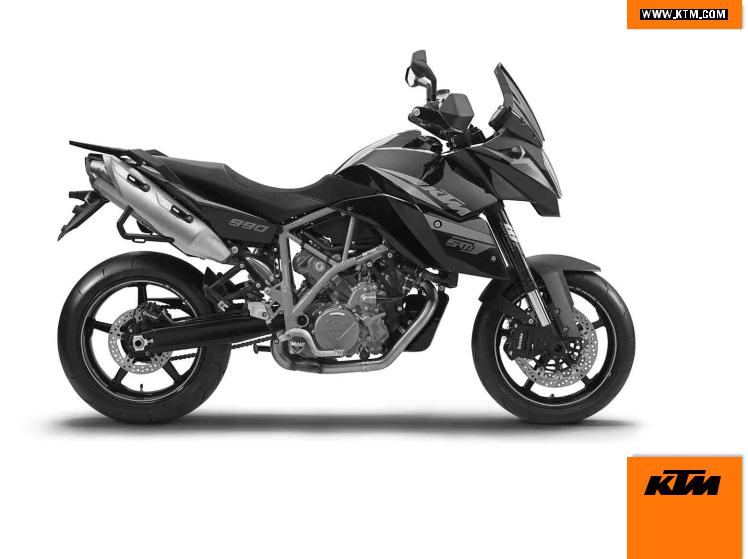
OWNER’S MANUAL 2013
990 Supermoto T EU
990 Supermoto T AUS/UK
990 Supermoto T FR
Art. no. 3211957en

Congratulations on your decision to purchase a KTM motorcycle. You are now the owner of a state-of-the-art sports motorcycle that will give you enormous pleasure if you service and maintain it accordingly.
We wish you a lot of enjoyment in riding this vehicle.
Please enter the serial numbers of your vehicle below.
|
Chassis number/type label |
Dealer’s stamp |
|
Engine number ( p. 21) |
|
|
Key number ( p. 21) |
|
The owner’s manual contained the latest information for this model at the time of going to print. Minor differences due to developments in design cannot be ruled out completely.
All specifications are non-binding. KTM Sportmotorcycle AG specifically reserves the right to modify or delete technical specifications, prices, colors, forms, materials, services, designs, equipment, etc., without prior notice and without specifying reasons, to adapt these to local conditions, as well as to stop production of a particular model without prior notice. KTM accepts no liability for delivery options, deviations from illustrations and descriptions, as well as printing and other errors. The models portrayed partly contain special equipment that does not belong to the regular scope of delivery.
© 2012 KTM-Sportmotorcycle AG, Mattighofen Austria All rights reserved
Reproduction, even in part, as well as copying of all kinds, is permitted only with the express written permission of the copyright owner.

ISO 9001(12 100 6061)
According to the international quality management standard ISO 9001, KTM uses quality assurance processes that lead to the maximum possible quality of the products.
Issued by: TÜV Management Service
KTM-Sportmotorcycle AG
5230 Mattighofen, Austria
TABLE OF CONTENTS
|
1 |
MEANS OF REPRESENTATION …………………………………. |
7 |
|
|
1.1 |
Symbols used ……………………………………………… |
7 |
|
|
1.2 |
Formats used………………………………………………. |
7 |
|
|
2 |
SAFETY ADVICE…………………………………………………….. |
8 |
|
|
2.1 |
Use definition — intended use ………………………….. |
8 |
|
|
2.2 |
Safety advice………………………………………………. |
8 |
|
|
2.3 |
Degrees of risk and symbols ……………………………. |
9 |
|
|
2.4 |
Tampering warning……………………………………….. |
9 |
|
|
2.5 |
Safe operation …………………………………………… |
10 |
|
|
2.6 |
Protective clothing ……………………………………… |
11 |
|
|
2.7 |
Work rules………………………………………………… |
11 |
|
|
2.8 |
Environment……………………………………………… |
11 |
|
|
2.9 |
Owner’s Manual …………………………………………. |
12 |
|
|
3 |
IMPORTANT NOTES……………………………………………… |
13 |
|
|
3.1 |
Guarantee, warranty ……………………………………. |
13 |
|
|
3.2 |
Operating substances ………………………………….. |
13 |
|
|
3.3 |
Spare parts, accessories ………………………………. |
13 |
|
|
3.4 |
Service ……………………………………………………. |
13 |
|
|
3.5 |
Figures ……………………………………………………. |
14 |
|
|
3.6 |
Customer service………………………………………… |
14 |
|
|
4 |
VIEW OF VEHICLE ……………………………………………….. |
16 |
|
|
4.1 |
View of vehicle, front left side (example) ………….. |
16 |
|
|
4.2 |
View of vehicle, rear right side (example)………….. |
18 |
|
|
5 |
SERIAL NUMBERS ………………………………………………. |
20 |
|
|
5.1 |
Chassis number …………………………………………. |
20 |
|
|
5.2 |
Type label ………………………………………………… |
20 |
|
|
5.3 |
Key number………………………………………………. |
21 |
|
|
5.4 |
Engine number ………………………………………….. |
21 |
|
|
5.5 |
Fork part number ……………………………………….. |
22 |
|
3 |
|||
|
5.6 |
Shock absorber part number …………………………. |
22 |
|
|
6 CONTROLS…………………………………………………………. |
23 |
||
|
6.1 |
Clutch lever………………………………………………. |
23 |
|
|
6.2 |
Hand brake lever………………………………………… |
23 |
|
|
6.3 |
Throttle grip ……………………………………………… |
24 |
|
|
6.4 |
Horn button………………………………………………. |
24 |
|
|
6.5 |
Light switch ……………………………………………… |
25 |
|
|
6.6 |
Headlight flasher switch ………………………………. |
25 |
|
|
6.7 |
Turn signal switch………………………………………. |
26 |
|
|
6.8 |
Emergency OFF switch ………………………………… |
26 |
|
|
6.9 |
Electric starter button………………………………….. |
27 |
|
|
6.10 |
Ignition/steering lock…………………………………… |
27 |
|
|
6.11 |
Immobilizer ………………………………………………. |
28 |
|
|
6.12 |
Combination instrument ………………………………. |
28 |
|
|
6.12.1 |
Overview ………………………………………………. |
28 |
|
|
6.12.2 |
Function buttons ……………………………………. |
29 |
|
|
6.12.3 |
Tachometer …………………………………………… |
29 |
|
|
6.12.4 |
indicator lamps………………………………………. |
30 |
|
|
6.12.5 |
Display ………………………………………………… |
31 |
|
|
6.12.6 |
Speed display………………………………………… |
32 |
|
|
6.12.7 |
Setting kilometers or miles ……………………….. |
32 |
|
|
6.12.8 |
Time……………………………………………………. |
33 |
|
|
6.12.9 |
Setting the clock ……………………………………. |
33 |
|
|
6.12.10 |
ODO display ………………………………………….. |
34 |
|
|
6.12.11 |
Setting/resetting display TRIP 1 …………………. |
34 |
|
|
6.12.12 |
Setting/resetting display TRIP 2 …………………. |
35 |
|
|
6.12.13 |
TRIP F display……………………………………….. |
36 |
|
|
6.12.14 |
Ambient temperature indicator…………………… |
36 |
|
|
6.12.15 |
Setting the temperature units…………………….. |
36 |
TABLE OF CONTENTS
|
6.12.16 |
Warning of icy roads………………………………… |
37 |
|
6.12.17 |
Coolant temperature indicator ……………………. |
38 |
6.13Hazard warning flasher switch/hazard warning
|
flasher …………………………………………………….. |
38 |
||
|
6.14 |
Socket for electrical accessories …………………….. |
39 |
|
|
6.15 |
Opening the filler cap………………………………….. |
39 |
|
|
6.16 |
Closing the filler cap …………………………………… |
40 |
|
|
6.17 |
Seat lock………………………………………………….. |
41 |
|
|
6.18 |
Tool set……………………………………………………. |
41 |
|
|
6.19 |
Handrails …………………………………………………. |
42 |
|
|
6.20 |
Helmet lock………………………………………………. |
42 |
|
|
6.21 |
Luggage rack plate……………………………………… |
43 |
|
|
6.22 |
Passenger footrests …………………………………….. |
43 |
|
|
6.23 |
Shift lever ………………………………………………… |
44 |
|
|
6.24 |
Foot brake lever …………………………………………. |
45 |
|
|
6.25 |
Side stand………………………………………………… |
45 |
|
|
7 |
PREPARING FOR USE…………………………………………… |
46 |
|
|
7.1 |
Information on first use ……………………………….. |
46 |
|
|
7.2 |
Running in the engine …………………………………. |
47 |
|
|
7.3 |
Loading the vehicle …………………………………….. |
47 |
|
|
8 |
RIDING INSTRUCTIONS………………………………………… |
50 |
8.1Checks and maintenance measures when
|
preparing for use………………………………………… |
50 |
|
|
8.2 |
Starting……………………………………………………. |
51 |
|
8.3 |
Starting off……………………………………………….. |
53 |
|
8.4 |
Shifting, riding ………………………………………….. |
53 |
|
8.5 |
Braking ……………………………………………………. |
56 |
|
8.6 |
Stopping, parking……………………………………….. |
58 |
|
8.7 |
Transport …………………………………………………. |
59 |
|
4 |
|||
|
8.8 |
Refueling …………………………………………………. |
60 |
|
|
9 |
SERVICE SCHEDULE ……………………………………………. |
62 |
|
|
9.1 |
Service schedule………………………………………… |
62 |
|
|
10 |
TUNING THE CHASSIS …………………………………………. |
65 |
|
|
10.1 |
Fork/shock absorber ……………………………………. |
65 |
|
|
10.2 |
Adjusting the compression damping of the fork….. |
65 |
|
|
10.3 |
Adjusting the rebound damping of the fork ……….. |
66 |
|
|
10.4 |
Adjusting the spring preload of the fork……………. |
67 |
|
|
10.5 |
Compression damping of the shock absorber……… |
69 |
10.6Adjusting the low-speed compression damping of
|
the shock absorber……………………………………… |
69 |
10.7Adjusting the high-speed compression damping
|
of the shock absorber ………………………………….. |
70 |
10.8Adjusting the rebound damping of the shock
|
absorber…………………………………………………… |
71 |
10.9Adjusting the spring preload of the shock
|
absorber…………………………………………………… |
72 |
|
11 SERVICE WORK ON THE CHASSIS…………………………… |
75 |
11.1Raising the motorcycle with the rear wheel
|
stand ………………………………………………………. |
75 |
11.2Taking the motorcycle off of the rear wheel
|
stand ………………………………………………………. |
75 |
11.3Raising the motorcycle with the front wheel
|
stand ………………………………………………………. |
76 |
11.4Taking the motorcycle off of the front wheel
|
stand ………………………………………………………. |
76 |
|
|
11.5 |
Bleeding the fork legs………………………………….. |
77 |
|
11.6 |
Removing the seat ……………………………………… |
77 |
|
11.7 |
Mounting the seat ………………………………………. |
78 |
|
11.8 |
Reinstalling the fuel tank……………………………… |
78 |
|
TABLE OF CONTENTS |
||
|
11.9 |
Positioning the fuel tank………………………………. |
79 |
|
11.10 |
Mounting the helmet lock on the vehicle ………….. |
80 |
|
11.11 |
Removing the mask spoiler …………………………… |
81 |
|
11.12 |
Installing the mask spoiler ……………………………. |
83 |
|
11.13 |
Checking the chain for dirt……………………………. |
84 |
|
11.14 |
Cleaning the chain ……………………………………… |
84 |
|
11.15 |
Checking the chain tension …………………………… |
86 |
|
11.16 |
Adjusting the chain tension…………………………… |
87 |
|
11.17 |
Checking the chain, rear sprocket, engine |
|
|
sprocket and chain guide……………………………… |
89 |
|
|
11.18 |
Adjusting the basic position of the clutch lever ….. |
92 |
|
11.19 |
Checking/rectifying the fluid level of the |
|
|
hydraulic clutch…………………………………………. |
92 |
|
|
12 BRAKES…………………………………………………………….. |
94 |
|
|
12.1 |
ABS/antilock brake system……………………………. |
94 |
12.2Adjusting the basic position of the hand brake
|
lever ……………………………………………………….. |
95 |
|
|
12.3 |
Checking the front brake discs ………………………. |
95 |
|
12.4 |
Checking the front brake fluid level ………………… |
96 |
|
12.5 |
Adding front brake fluid x…………………………… |
97 |
|
12.6 |
Checking the front brake linings …………………….. |
98 |
|
12.7 |
Checking the free travel of the foot brake lever…… |
99 |
12.8Adjusting the basic position of the foot brake
|
lever ……………………………………………………… |
100 |
|
|
12.9 |
Checking the rear brake disc ……………………….. |
101 |
|
12.10 |
Checking the rear brake fluid level………………… |
101 |
|
12.11 |
Adding rear brake fluid x………………………….. |
102 |
|
12.12 |
Checking the rear brake linings ……………………. |
104 |
|
5 |
|||
|
13 |
WHEELS, TIRES ………………………………………………… |
106 |
|
|
13.1 |
Removing the front wheel x………………………. |
106 |
|
|
13.2 |
Installing the front wheel x……………………….. |
107 |
|
|
13.3 |
Removing the rear wheel x………………………… |
109 |
|
|
13.4 |
Installing the rear wheel x………………………… |
111 |
|
|
13.5 |
Checking the rear hub rubber dampers x………. |
113 |
|
|
13.6 |
Checking the tire condition …………………………. |
114 |
|
|
13.7 |
Checking the tire air pressure………………………. |
115 |
|
|
14 |
ELECTRICAL SYSTEM …………………………………………. |
117 |
|
|
14.1 |
Removing the battery x……………………………. |
117 |
|
|
14.2 |
Installing the battery x…………………………….. |
119 |
|
|
14.3 |
Recharging the battery x………………………….. |
120 |
|
|
14.4 |
Changing the main fuse……………………………… |
122 |
|
|
14.5 |
Changing the ABS fuses …………………………….. |
124 |
14.6Changing the fuses of individual power
|
consumers………………………………………………. |
125 |
|
|
14.7 |
Changing the headlight bulb ……………………….. |
127 |
|
14.8 |
Changing the parking light bulb……………………. |
129 |
|
14.9 |
Changing the turn signal bulb ……………………… |
131 |
|
14.10 |
Changing the brake light bulb ……………………… |
131 |
|
14.11 |
Changing the tail light bulbs ……………………….. |
136 |
|
14.12 |
Changing the license plate lamp…………………… |
141 |
|
14.13 |
Checking the headlight setting …………………….. |
143 |
|
14.14 |
Adjusting the headlight range………………………. |
143 |
|
14.15 |
Activating/deactivating the ignition key ………….. |
144 |
|
15 COOLING SYSTEM ……………………………………………… |
149 |
|
|
15.1 |
Cooling system ………………………………………… |
149 |
|
15.2 |
Checking the antifreeze and coolant level ……….. |
149 |
|
TABLE OF CONTENTS |
6 |
||||||
|
15.3 |
Checking the coolant level in the compensating |
23 |
TECHNICAL DATA………………………………………………. |
188 |
|||
|
tank………………………………………………………. |
152 |
23.1 |
Engine …………………………………………………… |
188 |
|||
|
15.4 |
Draining the coolant x……………………………… |
153 |
23.2 |
Engine tightening torques …………………………… |
189 |
||
|
15.5 |
Filling/bleeding the cooling system x…………… |
154 |
23.3 |
Capacities ………………………………………………. |
192 |
||
|
16 |
TUNING THE ENGINE…………………………………………. |
157 |
23.3.1 |
Engine oil …………………………………………… |
192 |
||
|
16.1 |
Checking the play in the throttle cable …………… |
157 |
23.3.2 |
Coolant ………………………………………………. |
192 |
||
|
16.2 |
Adjusting the play in the throttle cable x………. |
158 |
23.3.3 |
Fuel ………………………………………………….. |
193 |
||
|
16.3 |
Plug-in connection, ignition timing map …………. |
158 |
23.4 |
Chassis ………………………………………………….. |
193 |
||
|
16.4 |
Adjusting the ignition curve to the fuel quality …. |
159 |
23.5 |
Electrical system………………………………………. |
194 |
||
|
16.5 |
Checking the basic position of the shift lever …… |
160 |
23.6 |
Tires ……………………………………………………… |
195 |
||
|
16.6 |
Adjusting the basic position of the shift |
23.7 |
Fork………………………………………………………. |
195 |
|||
|
lever x…………………………………………………. |
160 |
23.8 |
Shock absorber………………………………………… |
196 |
|||
|
17 SERVICE WORK ON THE ENGINE ………………………….. |
162 |
23.9 |
Chassis tightening torques ………………………….. |
198 |
|||
|
17.1 |
Checking the engine oil level……………………….. |
162 |
24 |
SUBSTANCES …………………………………………………… |
202 |
||
|
17.2 |
Changing the engine oil and filter, cleaning the |
25 |
AUXILIARY SUBSTANCES ……………………………………. |
206 |
|||
|
oil screens x………………………………………….. |
163 |
26 |
STANDARDS …………………………………………………….. |
209 |
|||
|
17.3 |
Draining the engine oil and filter, cleaning the |
163 |
INDEX ……………………………………………………………………. |
210 |
|||
|
oil screens x………………………………………….. |
|||||||
|
17.4 |
Filling up with engine oil x……………………….. |
168 |
|||||
|
17.5 |
Adding engine oil……………………………………… |
169 |
|||||
|
18 |
CLEANING, CARE ………………………………………………. |
170 |
|||||
|
18.1 |
Cleaning motorcycle ………………………………….. |
170 |
18.2Checks and maintenance measures for winter
|
operation………………………………………………… |
172 |
||
|
19 |
STORAGE…………………………………………………………. |
174 |
|
|
19.1 |
Storage ………………………………………………….. |
174 |
|
|
19.2 |
Preparing for use after storage……………………… |
176 |
|
|
20 |
TROUBLESHOOTING ………………………………………….. |
177 |
|
|
21 |
IMMOBILIZER BLINK CODE …………………………………. |
180 |
|
|
22 |
ENGINE CONTROL BLINK CODE……………………………. |
182 |
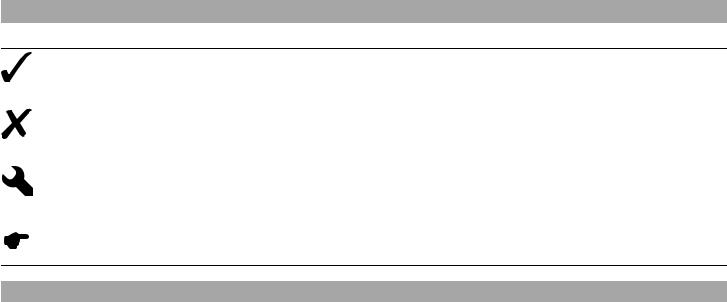
|
1 |
MEANS OF REPRESENTATION |
7 |
1.1Symbols used
The meaning of specific symbols is described below.
Indicates an expected reaction (e.g. of a work step or a function).
Indicates an unexpected reaction (e.g. of a work step or a function).
All work marked with this symbol requires specialist knowledge and technical understanding. In the interest of your own safety, have these jobs performed by an authorized KTM workshop. There, your motorcycle will be optimally cared for by specially trained experts using the specialist tools required.
Indicates a page reference (more information is provided on the specified page).
1.2Formats used
The typographical formats used in this document are explained below.
|
Specific name |
Identifies a proprietary name. |
|
Name® |
Identifies a protected name. |
|
Brand™ |
Identifies a brand available on the open market. |

2.1Use definition — intended use
KTM sport motorcycles are designed and constructed to meet the normal demands of regular road operation but not for use on race courses or offroad.
Info
The motorcycle is only authorized for operation on public roads in the homologated version.
2.2Safety advice
A number of safety instructions need to be followed to operate the vehicle safely. Therefore, read this manual carefully. The safety instructions are highlighted in the text and are referred to at the relevant passages.
Info
The vehicle has various information and warning labels at prominent locations. Do not remove information/warning labels. If they are missing, you or others may not recognize dangers and may therefore be injured.
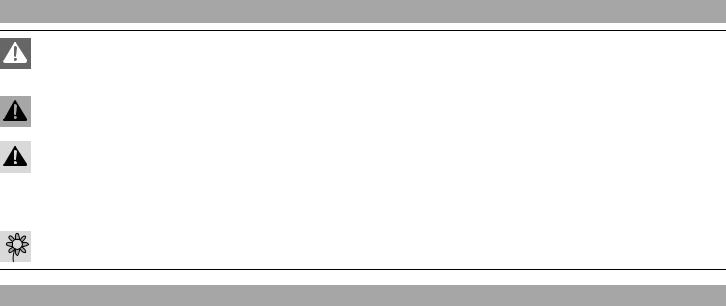
2.3Degrees of risk and symbols
Danger
Identifies a danger that will immediately and invariably lead to fatal or serious permanent injury if the appropriate measures are not taken.
Warning
Identifies a danger that is likely to lead to fatal or serious injury if the appropriate measures are not taken.
Caution
Identifies a danger that may lead to minor injuries if the appropriate measures are not taken.
Note
Identifies a danger that will lead to considerable machine and material damage if the appropriate measures are not taken.
Warning
Identifies a danger that will lead to environmental damage if the appropriate measures are not taken.
2.4Tampering warning
Tampering with the noise control system is prohibited. Federal law prohibits the following acts or the causing thereof:
1The removal or rendering inoperative by any person other than for purposes of maintenance, repair, or replacement, of any device or element of design incorporated into any new vehicle for the purpose of noise control prior to its sale or delivery to the ultimate purchaser or while it is in use, or
2the use of the vehicle after such device or element of design has been removed or rendered inoperative by any person.
Among those acts presumed to constitute tampering are the acts listed below:

1Removal or puncturing of the main silencer, baffles, header pipes or any other components which conduct exhaust gases.
2Removal or puncturing of any part of the intake system.
3Lack of proper maintenance.
4Replacing any moving part of the vehicle, or parts of the exhaust or intake system, with parts other than those specified by the manufacturer.
2.5Safe operation
Danger
Danger of accidents Danger arising from the rider’s judgement being impaired.
–Do not operate the vehicle while under the influence of alcohol, drugs and certain medications or physically or mentally impaired.
Danger
Danger of poisoning Exhaust gases are toxic and inhaling them may result in unconsciousness and/or death.
–When running the engine, always make sure there is sufficient ventilation, and do not start or run the engine in an enclosed space without an effective exhaust extraction system.
Warning
Danger of burns Some vehicle components become very hot when the vehicle is operated.
–Do not touch hot components such as exhaust system, radiator, engine, shock absorber, and the brake system. Allow these components to cool down before starting work on them.
Only operate the vehicle when it is in perfect technical condition, in accordance with its intended use, and in a safe and environmentally compatible manner.
The vehicle should only be used by trained persons. An appropriate driver’s license is needed to ride the vehicle on public roads. Have malfunctions that impair safety promptly eliminated by an authorized KTM workshop.
Adhere to the information and warning labels on the vehicle.
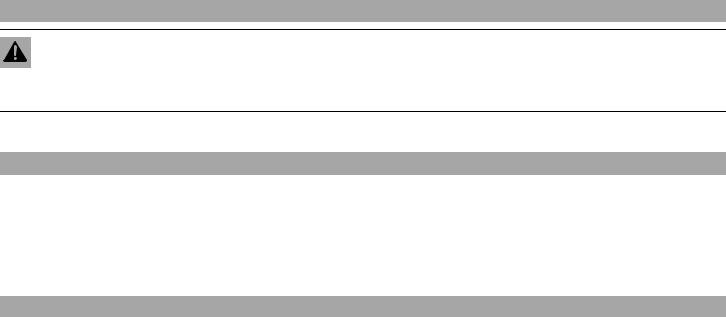
2.6Protective clothing
Warning
Risk of injury Missing or poor protective clothing presents an increased safety risk.
–Wear protective clothing (helmet, boots, gloves, pants and jacket with protectors) every time you ride the vehicle. Always wear protective clothing that is in good condition and meets the legal requirements.
In the interest of your own safety, KTM recommends that you only operate the vehicle while wearing protective clothing.
2.7Work rules
Special tools are necessary for certain tasks. The tools are not contained in the vehicle but can be ordered under the number in parentheses. E.g.: bearing puller (15112017000)
During assembly, non-reusable parts (e.g. self-locking screws and nuts, seals and seal rings, O-rings, pins, lock washers) must be replaced by new parts.
In some instances, a thread locker (e.g. Loctite®) is required. The manufacturer instructions for use must be followed.
After disassembly, clean the parts that are to be reused and check them for damage and wear. Change damaged or worn parts. After you complete the repair or service work, check the operating safety of the vehicle.
2.8Environment
If you use your motorcycle responsibly, you can ensure that problems and conflicts do not occur. To protect the future of the motorcycle sport, make sure that you use your motorcycle legally, display environmental consciousness, and respect the rights of others.
When disposing of used oil, other operating and auxiliary fluids, and used components, comply with the laws and regulations of the respective country.
Because motorcycles are not subject to the EU regulations governing the disposal of used vehicles, there are no legal regulations that pertain to the disposal of an end-of-life motorcycle. Your authorized KTM dealer will be glad to advise you.

2.9Owner’s Manual
It is important that you read this Owner’s Manual carefully and completely before making your first trip. The Owner’s Manual contains useful information and many tips on how to operate, handle, and maintain your motorcycle. Only then will you find out how to customize the vehicle ideally for your own use and how you can protect yourself from injury.
Keep the Owner’s Manual in an accessible place to enable you to refer to it as needed.
If you would like to know more about the vehicle or have questions on the material you read, please contact an authorized KTM dealer. The Owner’s Manual is an important component of the vehicle and should be handed over to the new owner if the vehicle is sold.
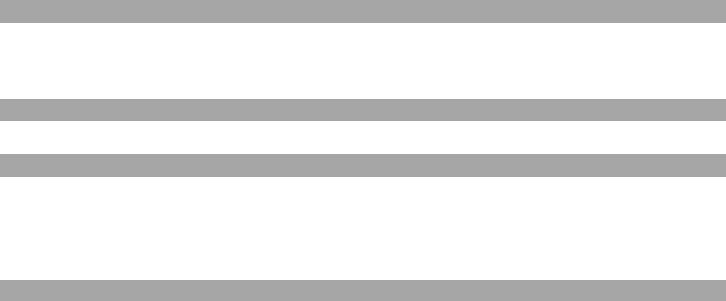
3.1Guarantee, warranty
The work prescribed in the service schedule must be carried out by an authorized KTM workshop only and confirmed in the customer’s service record and in the KTM dealer.net; otherwise, all warranty claims will be void. No warranty claims can be considered for damage resulting from manipulations and/or alterations to the vehicle.
Additional information on the guarantee or warranty and the procedures involved can be found in the service record.
3.2Operating substances
The fuels and lubricants named in the owner’s manual must be used according to specifications.
3.3Spare parts, accessories
For your own safety, only use spare parts and accessory products that are approved and/or recommended by KTM and have them installed by an authorized KTM workshop. KTM accepts no liability for other products and any resulting damage or loss.
Certain spare parts and accessory products are specified in parentheses in the descriptions. Your KTM dealer will be glad to advise you.
The current KTM PowerParts for your vehicle can be found on the KTM website.
International KTM Website: http://www.ktm.com
3.4Service
A prerequisite for perfect operation and prevention of premature wear is that the service, care, and tuning work on the engine and chassis is properly carried out as described in the Owner’s Manual. Incorrect adjustment and tuning of the engine and chassis can lead to damage and breakage of components.
Use of the vehicle under difficult conditions, such in rain, high heat or with a heavy load, can lead to considerably more rapid wear of components such as the drive train, brake system, or suspension components. For this reason, it may be necessary to inspect or replace parts before the next scheduled service.
It is imperative that you adhere to the stipulated run-in times and service intervals. If you observe these exactly, you will ensure a much longer service life for your motorcycle.

3.5Figures
The figures contained in the manual may depict special equipment.
In the interest of clarity, some components may be shown disassembled or may not be shown at all. It is not always necessary to disassemble the component to perform the activity in question. Please follow the instructions in the text.
3.6Customer service
Your authorized KTM dealer will be happy to answer any questions you may have on your vehicle and KTM.
A list of authorized KTM dealers can be found on the KTM website.
International KTM Website: http://www.ktm.com
15

4.1View of vehicle, front left side (example)
L00600-10

|
4 |
VIEW OF VEHICLE |
17 |
|
1 |
Function buttons ( p. 29) |
1indicator lamps (
2Clutch lever (
3Handrails (
4Level viewer, engine oil
5Shift lever (
6Engine number (
7Compression damping of the shock absorber (
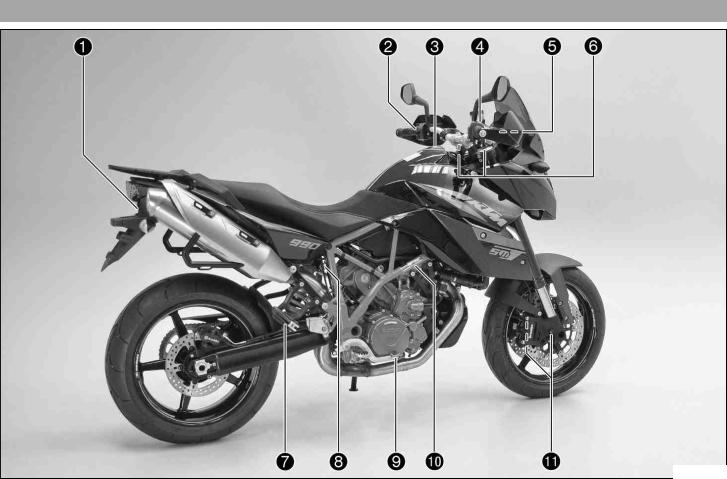
4.2View of vehicle, rear right side (example)
L00601-10

1Seat lock (
2Light switch (
|
2 |
Headlight flasher switch ( p. 25) |
|
2 |
Turn signal switch ( p. 26) |
2Horn button (
3Filler cap
4Emergency OFF switch (
4Electric starter button (
5Hand brake lever (
6Fork rebound setting and spring preload setting
7Passenger footrests (
8Shock absorber setting, spring preload adjuster
9Foot brake lever (
10Chassis number/type label
11Fork compression adjustment
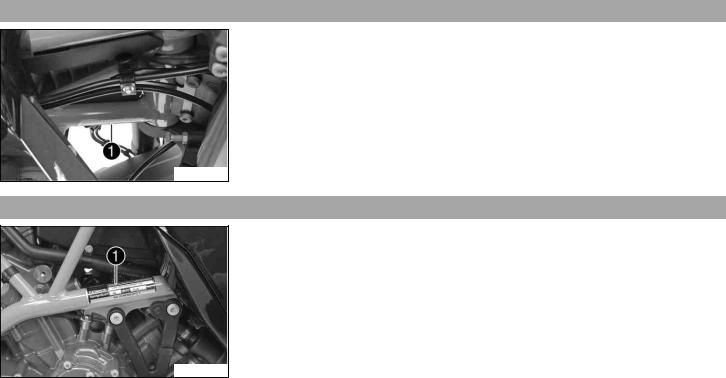
5.1Chassis number
Chassis number 1 is embossed in the steering head at the right.
L00604-10
5.2Type label
Type label 1 is located on the upper frame tube on the right.
L00603-10
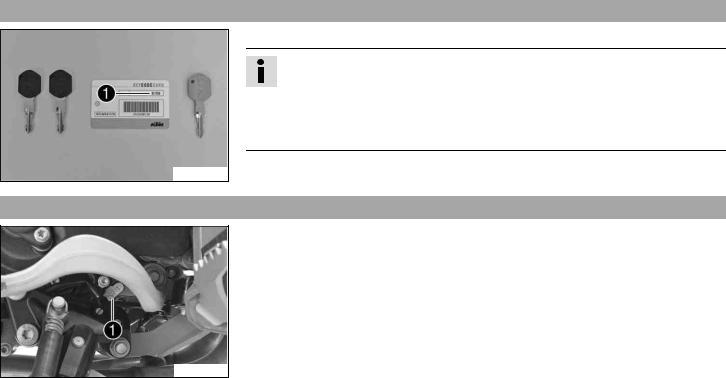
5.3Key number
The Code number 1 key number can be found on the KEYCODECARD.
Info
You need the key number to order a spare key. Keep the KEYCODECARD in a safe place.
Use the orange programming key to activate and deactivate the black ignition key. Keep the orange programming key in a safe place: it must only be used for learning and programming functions.
700563-01
5.4Engine number
The engine number 1 is stamped on the left side of the engine under the engine sprocket.
L00602-10
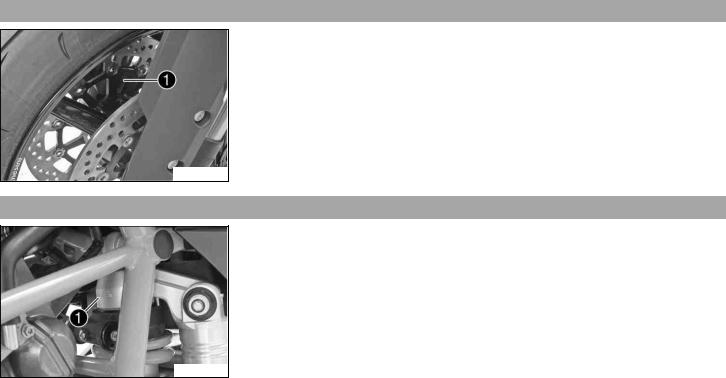
5.5Fork part number
The fork part number 1 is stamped on the inner side of the fork stub.
B00606-10
5.6Shock absorber part number
The shock absorber part number 1 is stamped on the top of the shock absorber above the adjusting ring on the engine side.
L00606-10
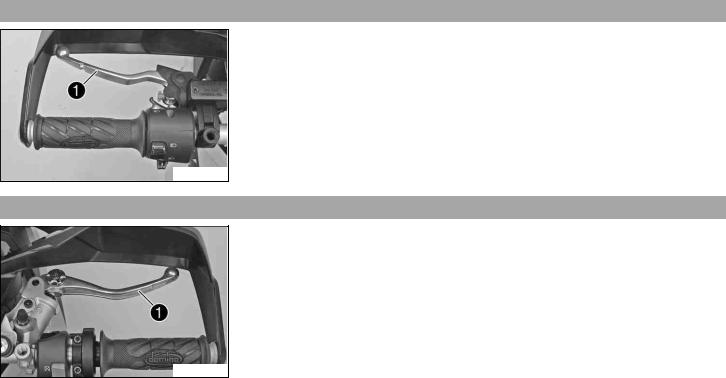
6.1Clutch lever
The clutch lever 1 is fitted on the left side of the handlebar.
The clutch is hydraulically operated and self-adjusting.
B00608-10
6.2Hand brake lever
The hand brake lever 1 is fitted on the right side of the handlebar.
The front brake is engaged using the hand brake lever.
B00609-10

6.3Throttle grip
The throttle grip 1 is fitted on the right side of the handlebar.
B00655-10
6.4Horn button
The horn button 1 is fitted on the left side of the handlebar.
Possible states
•Horn button 
•Horn button 
B00656-12
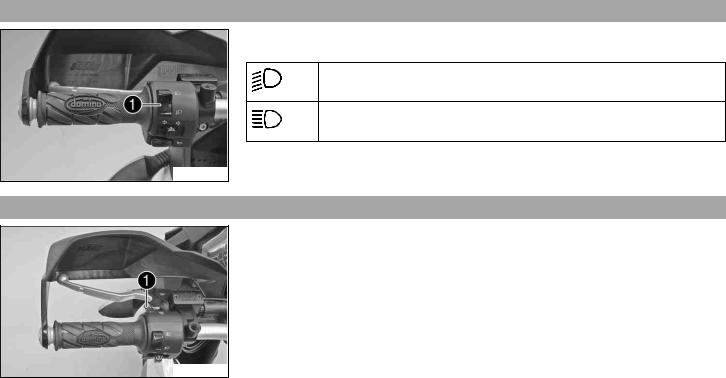
6.5Light switch
The light switch 1 is fitted on the left side of the handlebar.
Possible states
Low beam on – The light switch is turned downward. In this position, the low beam and tail light are switched on.
High beam on – The light switch is turned upwards. In this position, the high beam and tail light are switched on.
B00684-10
6.6Headlight flasher switch
The headlight flasher switch 1 is fitted on the left side of the handlebar.
Possible states
•Headlight flasher switch in basic position
•Headlight flasher switch pressed – The headlight flasher switch (high beam) is operated in this position.
B00685-10
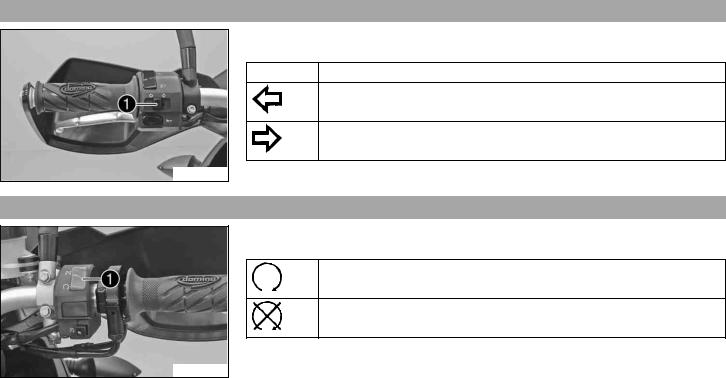
6.7Turn signal switch
B00656-11
The turn signal switch 1 is fitted on the left side of the handlebar.
Possible states
Turn signal off
Left turn signal on – The turn signal switch is pressed to the left. The turn signal switch automatically returns to the central position after use.
Right turn signal on – The turn signal switch is pressed to the right. The turn signal switch automatically returns to the central position after use.
To switch off the turn signal, press the turn signal switch towards the switch case.
6.8Emergency OFF switch
The emergency OFF switch 1 is fitted on the right side of the handlebar.
Possible states
Emergency OFF switch on – This position is necessary for operation as it closes the ignition circuit.
Emergency OFF switch off – In this position, the ignition circuit is interrupted, a running engine stops, and the engine cannot be started.
B00657-10
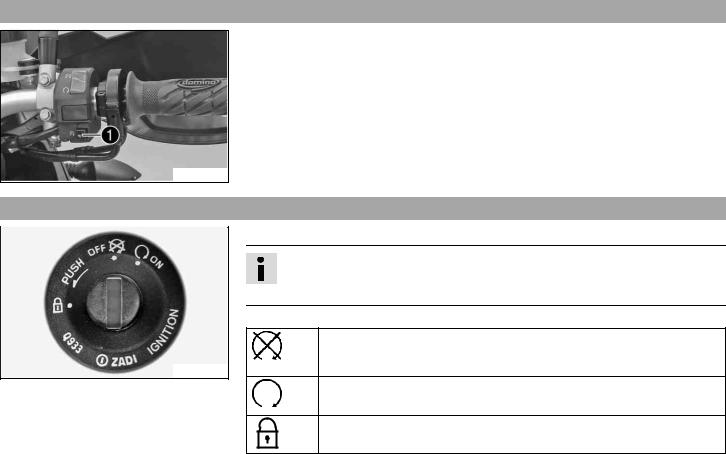
6.9Electric starter button
The electric starter button 1 is fitted on the right side of the handlebar.
Possible states
•Electric starter button 
•Electric starter button 
B00657-11
6.10Ignition/steering lock
600825-01
The ignition/steering lock is in front of the upper triple clamp.
Info
The ignition may only be switched on using a black ignition key.
Use the orange programming key to activate and deactivate the black ignition key.
Possible states
Ignition OFF – In this position, the ignition circuit is interrupted, a running engine stops, and a non-running engine will not start. The ignition key can be removed.
Ignition ON – In this position, the ignition circuit is closed and the engine can be started.
Steering locked – In this position, the ignition circuit is interrupted and the steering locked. The ignition key can be removed.

|
6 |
CONTROLS |
28 |
||||||
|
6.11 |
Immobilizer |
|||||||
|
The electronic immobilizer secures the vehicle against unauthorized use. |
||||||||
|
The immobilizer is activated automatically and the engine electronics are locked when the |
||||||||
|
ignition key is withdrawn. |
||||||||
|
The red warning lamp |
flashes at 15 second intervals after one minute. |
|||||||
|
The red warning lamp can also indicate errors by flashing. |
||||||||
|
Info |
||||||||
|
The ignition key contains electronic components. Never attach multiple ignition keys |
||||||||
|
to a single key ring; this may cause mutual interference and lead to problems. |
||||||||
|
400887-01 |
A lost black ignition key must be deactivated to prevent unauthorized persons from operat- |
|||||||
|
ing the vehicle. |
||||||||
|
The second black ignition key is activated when the vehicle is shipped. |
||||||||
|
Another two spare ignition keys (key number on the KEYCODECARD) can be ordered from an |
||||||||
|
authorized KTM workshop, but they need to be activated for use. |
6.12Combination instrument
6.12.1Overview
The combination instrument is installed in front of the handlebar. The combination instrument is divided into 4 function areas.
1 Function buttons
2 Tachometer
3 Indicator lights
4 Display
400885-10
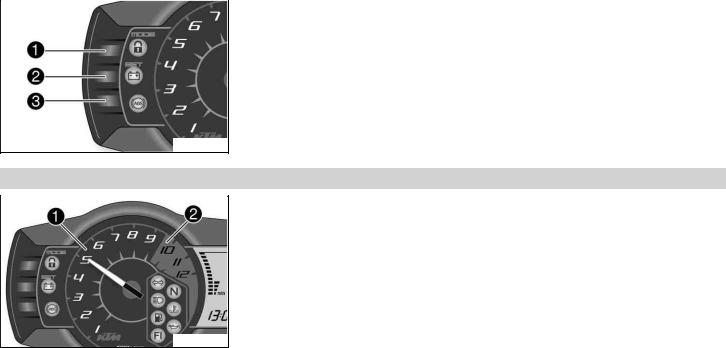
|
6 |
CONTROLS |
29 |
|
6.12.2 |
Function buttons |
|
|
You can change the display mode with the MODE button 1. |
||
|
Possible display modes are the distance traveled (ODO), trip master 1 (TRIP 1), trip mas- |
||
|
ter 2 (TRIP 2), and the ambient temperature. |
||
|
Press the SET button 2 to reset the trip master 1 function (TRIP 1) and trip master 2 func- |
||
|
tion (TRIP 2) to 0.0. |
||
|
The ABS can be switched off using button 3. |
400886-10
6.12.3Tachometer
The tachometer 1 shows the engine speed in revolutions per minute.
The red marking 2 shows the excess speed range of the engine.
400888-10
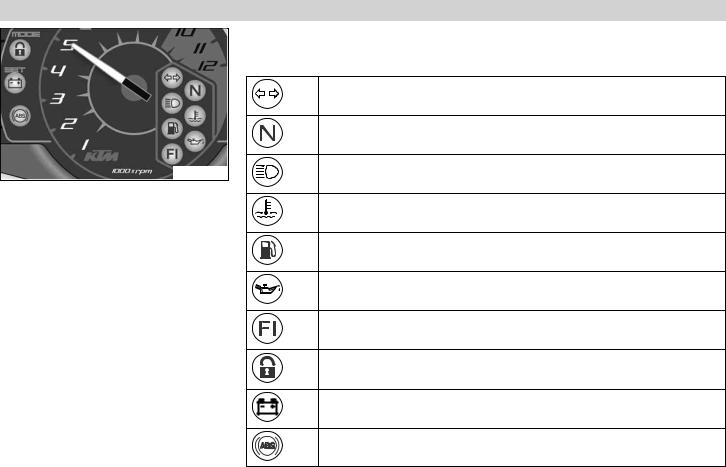
6.12.4indicator lamps
400889-01
The indicator lamps offer additional information about the operating state of the motorcycle.
Possible states
The turn signal indicator light flashes green simultaneously with the turn signal – The turn signal is switched on.
The idling speed indicator lamp lights up green – The transmission is shifted to idle.
The high beam indicator light lights up blue – The high beam is switched on.
The temperature warning lamp lights up red – The coolant temperature has reached a critical value.
The low fuel warning lamp lights up yellow – The fuel level has reached the reserve mark. The display switches to TRIP F.
The oil pressure warning lamp lights up red – The oil pressure is too low.
FI warning lamp (MIL) lights up/flashes yellow – The OBD (on-board diagnosis) has detected an emissionor safety-critical error.
The immobilizer indicator lamp lights up or flashes red – Status or error message for immobilizer/alarm system.
The battery warning lamp lights up red – The voltage in the vehicle system is too low.
ABS warning lamp lights up/flashes yellow – Status or error messages relating to ABS (antilock brake system).
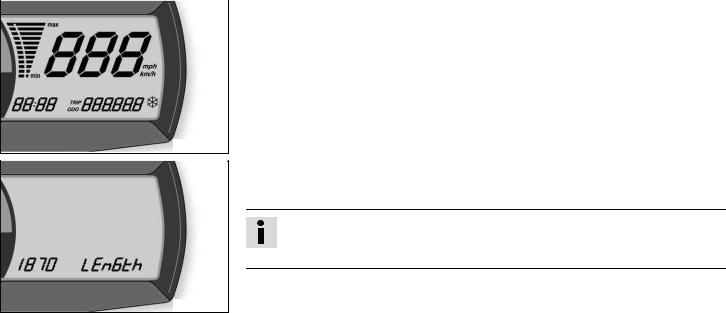
|
6 |
CONTROLS |
31 |
|
6.12.5 |
Display |
|
|
When you switch on the ignition, all display segments light up for one second as a function |
||
|
check. |
400892-01
LEnGth
Following the display function check, the LEnGth wheel circumference is shown for one second.
Info
1870 mm corresponds to the circumference of the 17″ front wheel with a series production tire.
The display then changes to the last selected mode.
400881-01
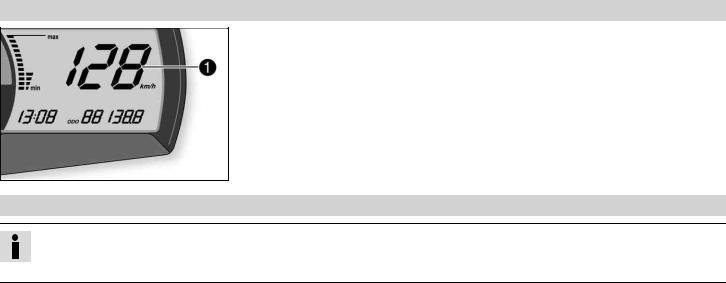
6.12.6Speed display
The speed 1 is shown in kilometers per hour km/h or in miles per hour mph.
400838-10
6.12.7Setting kilometers or miles
Info
If you change the unit, the value ODO is retained and converted accordingly.
Making the setting according to the country.
Condition
The motorcycle is stationary.

6 CONTROLS
33
–Switch on the ignition by turning the ignition key to the ON 
–Press the MODE button repeatedly until the ODO mode is active.
–Keep the MODE button pressed until the display mode changes from km/h to mph or from mph to km/h.
400893-10
6.12.8Time
The time is shown in area 1 of the display.
Info
After reconnecting the battery or changing the fuse, the time must be reset.
400893-11
6.12.9Setting the clock
Condition
The motorcycle is stationary.
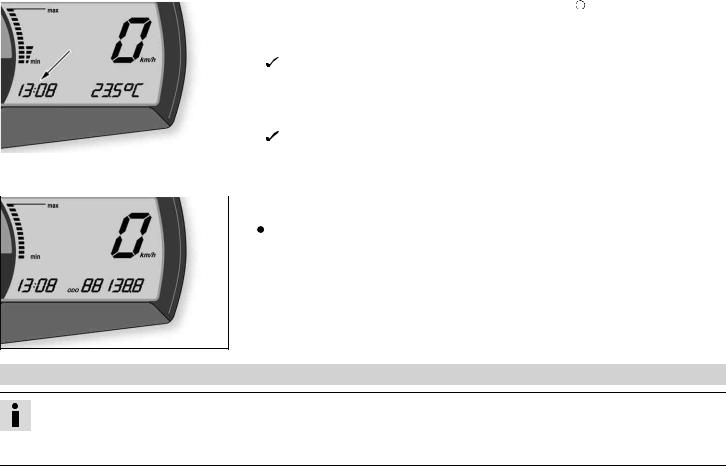
|
6 |
CONTROLS |
34 |
||||||
|
– Switch on the ignition by turning the ignition key to the ON |
position. |
|||||||
|
– Press the MODE button repeatedly until the ODO mode is active. |
||||||||
|
– Keep the MODE button and the SET button pressed simultaneously. |
||||||||
|
The time display begins to flash. |
||||||||
|
– Press the MODE button to set the hour. |
||||||||
|
– Press the SET button to set the minute. |
||||||||
|
– Keep the MODE button and the SET button pressed simultaneously. |
||||||||
|
The time is set. |
||||||||
|
400893-12 |
||||||||
|
6.12.10 |
ODO display |
|||||||
|
In the ODO display mode, the total distance traveled is shown in kilometers or miles. |
||||||||
|
Info |
||||||||
|
This value is retained, even if the battery is disconnected and/or the fuse blows. |
||||||||
400839-01
6.12.11 Setting/resetting display TRIP 1
Info
The TRIP 1 trip counter is always running and counts up to 999.9.
The trip counter can be used to measure the distance covered during trips or between two refueling stops. After the value 999.9 is reached, the trip counter starts at 0.0 again.
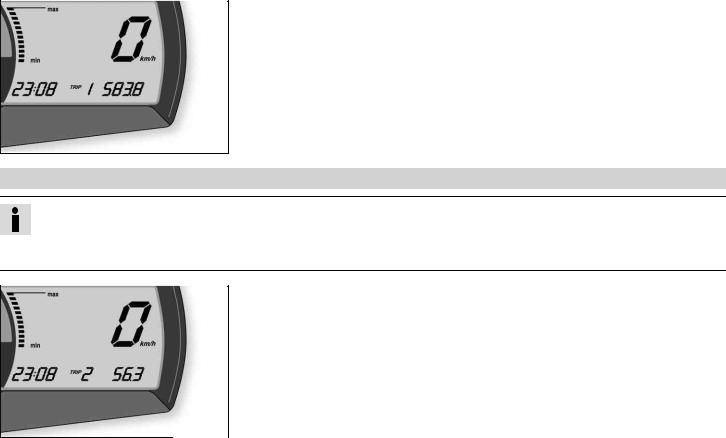
6 CONTROLS
35
–Switch on the ignition by turning the ignition key to the ON 
–Press the MODE button repeatedly until the TRIP 1 mode is active.
–Keep the SET button pressed.

400840-01
6.12.12 Setting/resetting display TRIP 2
Info
The TRIP 2 trip counter is always running and counts up to 999.9.
The trip counter can be used to measure the distance covered during trips or between two refueling stops. After the value 999.9 is reached, the trip counter starts at 0.0 again.
–Switch on the ignition by turning the ignition key to the ON 
–Press the MODE button repeatedly until the TRIP 2 mode is active.
–Keep the SET button pressed.

400841-01
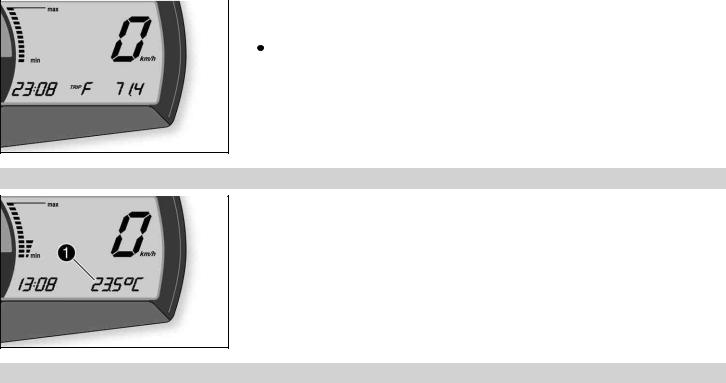
|
6 |
CONTROLS |
36 |
||||
|
6.12.13 |
TRIP F display |
|||||
|
If the fuel level drops to the reserve mark, the display automatically changes to TRIP F and |
||||||
|
starts to count from 0.0, regardless of the previous display mode. |
||||||
|
Info |
||||||
|
The low fuel warning lamp lights up in parallel to the TRIP F display. |
||||||
400842-01
6.12.14 Ambient temperature indicator
The ambient temperature 1 is displayed in °C or °F.
400893-13
6.12.15 Setting the temperature units
Condition
The motorcycle is stationary.
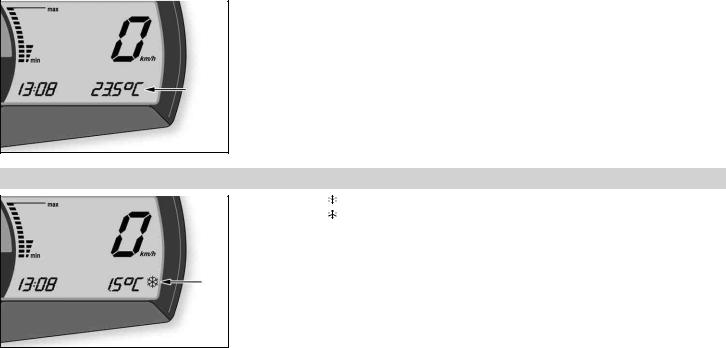
6 CONTROLS
37
–Switch on the ignition by turning the ignition key to the ON 
–Press the MODE button repeatedly until the ambient temperature is active.
–Keep the MODE button pressed until the display mode changes from °C to °F or from °F to °C.
400893-14
6.12.16 Warning of icy roads
|
The ice symbol |
lights up to indicate an increased danger of slippery roads. |
|
|
The ice symbol |
appears in the display when the ambient temperature drops below the |
|
|
specified value. |
||
|
Temperature |
3 °C (37 °F) |
|
The ice symbol 
400894-10
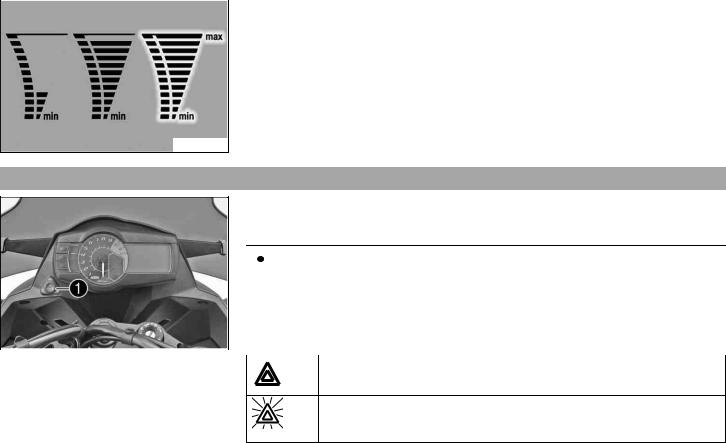
|
6 |
CONTROLS |
38 |
|
6.12.17 |
Coolant temperature indicator |
|
|
The temperature display consists of 12 bars. The more bars that light up, the hotter the |
||
|
coolant. When the upper bar lights up, all bars in the display begin to flash and the temper- |
||
|
ature warning lamp lights up. |
Possible states
•Engine cold – Up to five bars light up.
•The engine is warm – Six to eleven bars light up.
•Engine hot – All twelve bars flash.
700124-01
6.13Hazard warning flasher switch/hazard warning flasher
The hazard warning flasher switch 1 is fitted next to the combination instrument on the left.
The hazard warning flasher is used to indicate emergency situations.
|
Info |
||||||
|
The hazard warning flasher can be activated or deactivated while the ignition is |
||||||
|
switched on or up to 30 seconds after the ignition is switched off. |
||||||
|
Do not keep the hazard warning flashers activated longer than necessary as they |
||||||
|
deplete the batteries. |
||||||
|
B00658-10 |
Possible states |
|||||
|
Hazard warning flasher off |
Hazard warning flasher on – All four turn signals, the hazard warning flasher switch, and the green turn signal indicator light in the combination instrument flash.
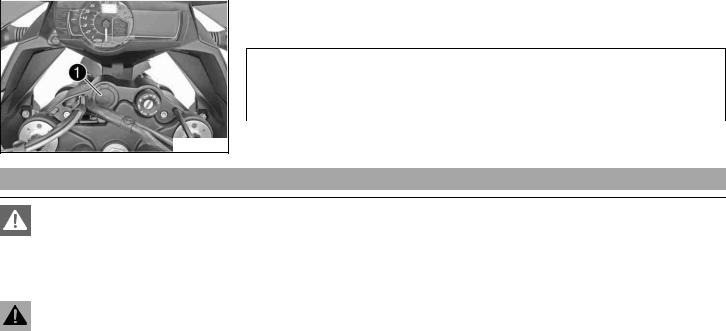
|
6 |
CONTROLS |
39 |
|
6.14 |
Socket for electrical accessories |
|
|
Socket 1 for electrical accessories is fitted next to the ignition/steering wheel lock on the |
||
|
left. |
||
|
It is connected to the battery without an additional switch. |
Socket for electrical accessories
|
Voltage |
12 V |
|
Maximum current con- |
10 A |
|
sumption |
|
B00614-10
6.15Opening the filler cap
Danger
Fire hazard Fuel is highly flammable.
–Never refuel the vehicle near open flames or burning cigarettes, and always switch off the engine first. Be careful that no fuel is spilt, especially on hot vehicle components. Clean up spilt fuel immediately.
–Fuel in the fuel tank expands when warm and can escape if the tank is overfilled. See the notes on refueling.
Warning
Danger of poisoning Fuel is poisonous and a health hazard.
–Avoid contact between fuel and skin, eyes and clothing. Do not inhale fuel vapors. If fuel gets into your eyes, rinse immediately with water and contact a doctor. Wash affected skin areas immediately with soap and water. If fuel is swallowed, contact a doctor immediately. Change clothing that has come into contact with fuel. Store fuel in a suitable canister according to regulations and keep it out of the reach of children.
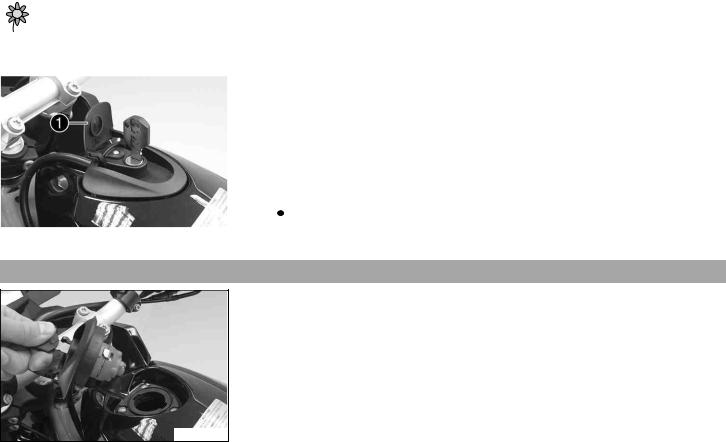
|
6 |
CONTROLS |
40 |
||||||
|
Warning |
||||||||
|
Environmental hazard Improper handling of fuel is a danger to the environment. |
||||||||
|
– Do not allow fuel to get into the ground water, the ground, or the sewage system. |
||||||||
|
– Lift the cover of the filler cap 1 and insert the ignition key. |
||||||||
|
Note |
||||||||
|
Danger of damage Ignition key breakage. |
||||||||
|
– To take pressure off of the ignition key, push down on the filler cap. Damaged igni- |
||||||||
|
tion keys must be replaced. |
||||||||
|
– Turn the ignition key 90° counterclockwise and remove the filler cap. |
||||||||
|
Info |
||||||||
|
L00607-10 |
||||||||
|
The filler cap has a tank air vent system. |
||||||||
6.16Closing the filler cap
–Put the filler cap back on and turn the ignition key 90° clockwise.
–Remove the ignition key and fold down the cover.
L00608-01
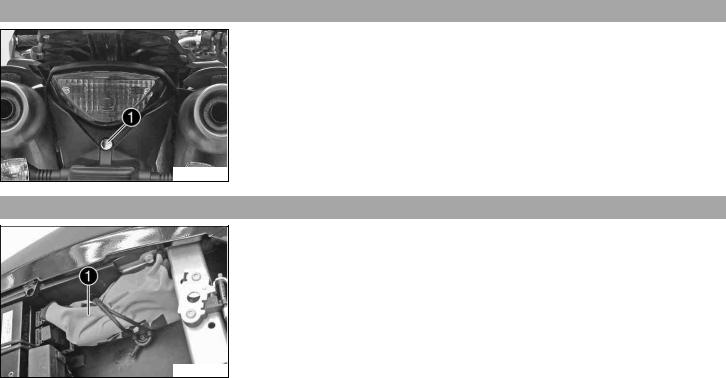
6.17Seat lock
Seat lock 1 is located at the rear under the tail light.
It can be locked with the ignition key.
600922-10
6.18Tool set
The tool set 1 is located in the storage compartment under the seat.
B00612-10
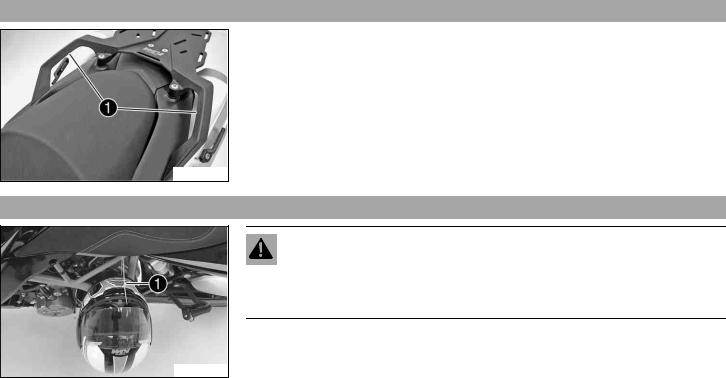
6.19Handrails
The handrails 1 are used for moving the motorcycle around.
If you carry a passenger, the passenger can hold onto the handrails during the trip.
600923-10
6.20Helmet lock
Warning
Danger of accidents Impairment of ride behavior and vehicle operation if a helmet or helmet lock is attached to the vehicle.
–Do not use the helmet lock for holding a helmet or other objects during the journey. Always remove the helmet lock before starting out.
The steel cable 1 in the tool set can be used to lock a helmet to the vehicle to prevent it from being stolen.
L00609-10
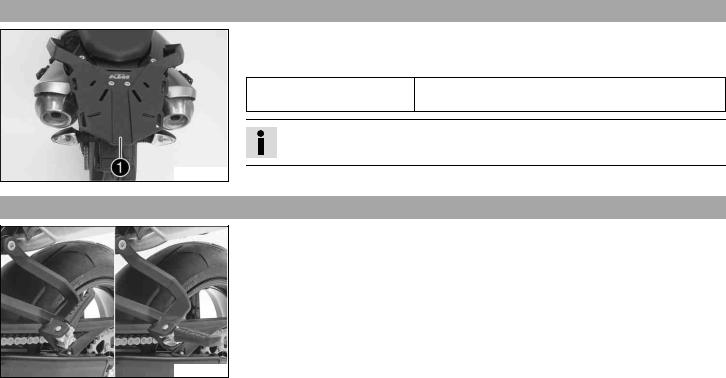
6.21Luggage rack plate
The luggage rack plate 1 is located behind the seat.
The base plate of a luggage system can be mounted on the luggage rack plate (optional).
The luggage rack plate may not be loaded with more than the specified weight.
Maximum permissible load of 8 kg (18 lb.) luggage rack plate
Info
Follow the instructions provided by the luggage manufacturer.
L00605-10
6.22Passenger footrests
The passenger footrests can be folded up and down.
Possible states
•Passenger footrests folded up – For operation without a passenger.
•Passenger footrests folded down – For operation with a passenger.
L00611-01
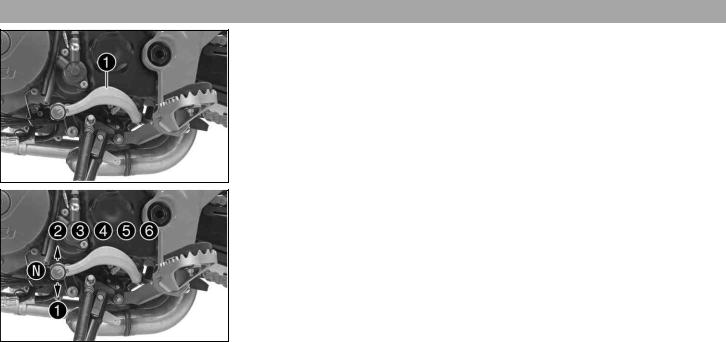
6.23Shift lever
Shift lever 1 is mounted on the left side of the engine.
L00610-11
The gear positions can be seen in the photograph.
The neutral or idle position N is between the first and second gear.
L00610-10

|
6 |
CONTROLS |
45 |
|
6.24 |
Foot brake lever |
|
|
Foot brake lever 1 is located in front of the right footrest. |
||
|
The rear brake is activated using the foot brake lever. |
L00613-10
The side stand 1 is located on the left side of the vehicle.
The side stand is used to park the motorcycle.
Info
The side stand must be folded up during motorcycle use.
The side stand is coupled with the safety starting system – see the riding instructions.
Possible states
•Side stand folded out – The vehicle can be supported on the side stand. The safety starting system is active.
•Side stand folded in – This position is mandatory when riding the motorcycle. The safety starting system is inactive.
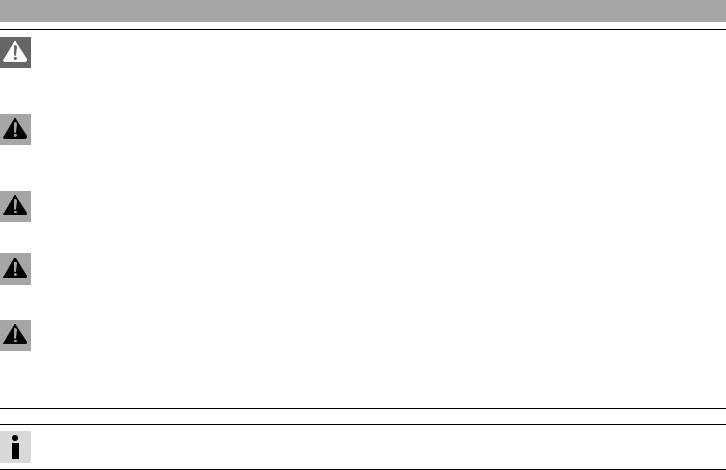
7.1Information on first use
Danger
Danger of accidents Danger arising from the rider’s judgement being impaired.
–Do not operate the vehicle while under the influence of alcohol, drugs and certain medications or physically or mentally impaired.
Warning
Risk of injury Missing or poor protective clothing presents an increased safety risk.
–Wear protective clothing (helmet, boots, gloves, pants and jacket with protectors) every time you ride the vehicle. Always wear protective clothing that is in good condition and meets the legal requirements.
Warning
Danger of crashing Poor vehicle handling due to different tire tread patterns on front and rear wheels.
–The front and rear wheels must be fitted with tires with similar tread patterns to prevent loss of control over the vehicle.
Warning
Danger of accidents Uncontrollable handling characteristic due to non-approved and/or non-recommended tires/wheels.
–Only tires/wheels approved by KTM and with the corresponding speed index should be used.
Warning
Danger of accidents Reduced road grip with new tires.
–New tires have a smooth rolling surface and therefore cannot provide full road grip. The entire rolling surface must be roughened in the first 200 kilometers (124.3 miles) by moderate riding at alternating angles. The full grip levels are not achieved until the tires have been run in.
Info
When using your vehicle, remember that others may feel disturbed by excessive noise.

–Make sure that the pre-delivery inspection work has been carried out by an authorized KTM workshop. 
–Before your first trip, read the entire operating instructions carefully.
–Familiarize yourself with the controls.
–Adjust the basic position of the clutch lever. (
–Adjust the basic position of hand brake lever. (
–Adjust the basic position of foot brake lever. (
–Get used to handling the vehicle on empty suitable terrain before making a longer trip. Try also to ride as slowly as possible to get a better feeling for the motorcycle.
–Hold the handlebar firmly with both hands and keep your feet on the footrests when riding.
–Run the engine in. (
7.2Running in the engine
–Do not exceed the specified engine speed and load during the running-in period. Guideline
Maximum engine speed
|
During the first: 1,000 km (621.4 mi) |
6,500 rpm |
|
|
After the first: 1,000 km (621.4 mi) |
9,600 rpm |
|
|
– Avoid full-throttle operation! |
7.3 Loading the vehicle
Warning
Danger of accidents Unstable handling characteristics.
– Do not exceed the maximum permitted weight and axle loads. The overall weight consists of: motorcycle operational and with a full tank, driver and passenger with protective clothing and helmet, baggage.

Warning
Danger of accidents Unstable handling characteristics due to incorrect mounting of suitcase and/or tank rucksack.
–Mount and secure suitcase and tank rucksack according to the manufacturer’s instructions.
Warning
Danger of accidents Unstable handling characteristics at high speed.
–Adapt your speed according to your payload. If the motorcycle is loaded with luggage, ride more slowly.
|
Maximum speed with luggage |
130 km/h (80.8 mph) |
Warning
Danger of accidents Destruction of luggage carrier system.
–If the motorcycle is fitted with luggage cases, note the manufacturer’s specifications concerning the maximum payload.
Warning
Danger of accidents Poor visibility for other road users due to slipped baggage.
–If the tail light is covered, you are less visible to traffic behind you, especially in the dark. Check that your baggage is fixed properly at regular intervals.
Warning
Danger of accidents Changed handling characteristics and longer stopping distance with excessive payload.
–Adapt your speed according to your payload.
Warning
Danger of accidents Unstable handling characteristics due to slipped baggage.
–Check the way your baggage is fixed regularly.
Warning
Danger of burns A hot exhaust system can burn baggage.
–Fasten your baggage in such a way that it cannot be burned or singed by the hot exhaust system.

User Manuals, Guides and Specifications for your KTM 990 SMT Motorcycle. Database contains 1 KTM 990 SMT Manuals (available for free online viewing or downloading in PDF): Owner’s manual .




